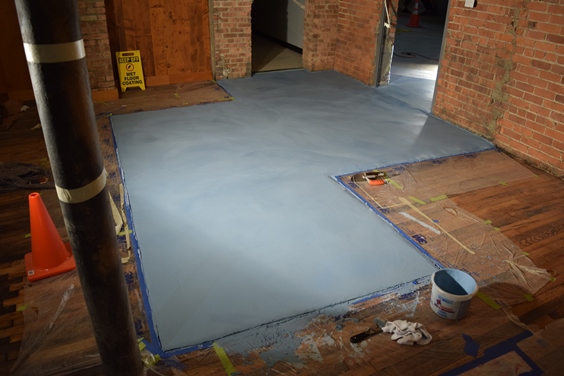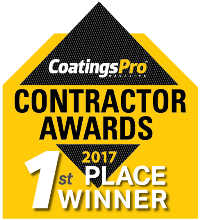In the revitalized downtown of Detroit, Michigan, a former Dongan Electric transformer factory is now a vibrant, multi-tenant office complex run by specialty food group Collaborative Advantage Marketing (CAM). CAM acquired the building two years ago and enlisted Premier Veneers, headed by owner Jeff Donius, to freshen it up with acid-stained decorative floors.
By size, the largest part of the job was the 2,200-square-foot (204.4 m2) main office area, which consisted of decorating new concrete. But even though it was barely over a tenth of the size, it was the 250-square-foot (23.2 m2) adjoining space — comprised of old concrete from the initial Dongan pour — that most befuddled Donius on his award-winning solo job.
“The biggest challenge and the most fun was trying to integrate those two areas,” Donius said. “In terms of condition, they were diametrically opposed. The challenge was to integrate those two and make it look like they were done at the same time.”
Time of the Essence
The plan was for CAM to move its operations and lease to other tenants in January. But due to delays with other trades, the project was behind schedule — and Donius wasn’t cleared to begin working until near Christmas! Even working 18-hour days, which he routinely did, and working around trades, he still couldn’t make up the gap.
“They had rented out the space as of January 1, so they were losing money,” Donius said. “They were anxious to get in, and I didn’t want to be the reason they continued to lose money.”
So besides bringing a strong work ethic, Donius got creative. With the project taking place during a cold Midwestern winter, propane heaters, blowers, and an industrial dehumidifier became essential for curing. But beyond that, Donius found he needed to stagger his work in both rooms — the new and old pours — to allow for scheduling efficiency.
“The area was small enough where I could put down a layer of material in an hour or two, and then go back into the other room while the material in the [small room] was setting,” Donius explained. “Then after several hours, once it was dry enough, I’d go in and do a second layer of application in the same day.”
Donius also saved time by sending the client acid-stained sample boards. “When you make a sample board beforehand, it helps you go through in your mind each stage of the project, and you can encounter issues on the sample board that you might otherwise encounter on the job and deal with them beforehand,” he said. “Because of that, I was able to avoid major issues on the job and maximize my use of time.”
Repairing and Prepping
Goggles, a Honeywell full-face air purifying respirator, and 3M’s disposable dust masks were safety essentials as Donius bounced between rooms. He used custom knee pads and anti-vibration work gloves when grinding and sanding, with a dust shroud and high-efficiency particulate air (HEPA) filter concrete dust collector from U.S. Saws.
The existing slab and adjacent pillar surfaces were ground clean with a L3206 heavy-duty sander from Porter-Cable, equipped with a turbo-cup diamond wheel. High spots and flares at transition points too large to grind flat were chipped level with Bosch’s Bulldog Xtreme rotary hammer drill. Edges and joints were smoothed with Metabo’s 4-inch (10.2 cm) angle grinder and diamond blade, and patching was done at various depths with materials including Sika’s Sikadur 31 epoxy mortar, Mapei’s Mapecem Quickpatch cement patch, and a polyurea structural repair product from Citadel Floors before being ground smooth with the sander.
Repair work concluded with the application of 4 quarts (0.9 L) of Pour-N-Restore oil stain remover to grease and oil stains, followed by skim-coating the surface with a gray Brickform SM Pro basecoat — trowel-applied at 0.125 inches (0.32 cm) of depth.

“This was the original concrete from the early 1900s, and it couldn’t have been in worse shape,” Donius recalled. “It was uneven, cracked, disjointed, damaged, dirty, stained, and impregnated with various fibrous materials and metal fittings.” He said the challenge was using repair materials in the right sequence to ensure compatibility.
“If not done correctly, the cracks and repairs could fail or reflect through to the surface, and existing stains or repair materials could leach to the surface and ruin the delicate coloring or the acid-stained cement overlay, or cause the sealer to fail,” Donius said. “I overcame this by using high-quality products I was familiar with, allowing them to completely cure, and ensuring that proper mechanical and chemical bonds were created.”
Transition Plan
With the old concrete repaired, Donius was almost ready to decorate! But on this job, he also had to map out the transition between rooms.
“The coloring from acid stains on [new] concrete, as opposed to cement overlays, is significantly different, and even more so when using a vibrant color, like blue,” Donius explained. “My idea was first to integrally color the overlay with liquid blue colorant, before staining it with the blue acid stain, to match the two areas more closely. Second, I extended the overlay into the other room past the threshold of the entryway by adding a saw-cut design. The owner loved it.”
The saw-cut transitions were made with a Mongoose decorative concrete engraving saw from Engrave-A-Crete with a 0.125-inch (0.32 cm) diamond blade.
Donius also opted for different sealers: a polyurea, which intensely enhances color, over the new pour, and a water-borne epoxy, which less intensely enhances color, over the vibrant, blue acid-stained overlay. Brown acid stain highlights were added to both. “The result was an effect that looked similar in both rooms but with slightly different toning,” he said.
With resurfacing complete, two coats of Brickform’s Triple Seven Bond Coat Primer were applied via roller as the foundation for the final overlay, followed by another trowel-applied coat of the Brickform SM Pro. Two coats of Brickform’s Micro-Topping with Liquid Polymer with a cobalt blue liquid colorant from Concrete Coatings, Inc. (CCI) were installed at 0.0625-inch (0.16 cm) each, using a Bon Tool plastic trowel. Any remaining gaps were filled with the epoxy mortar, and the floor was cleaned using a Bissell BGLB9000 machine and Norton’s 17-inch (43.2 cm), 120-grit and 150-grit screen disc sanding kit.
At this point, the finishing touches were all that remained! Using 2.5-gallon (9.5 L) pump-up sprayers and handheld water misters, Donius lightly applied the same blue, reddish brown, and medium brown staining products as in the main area before rinsing away stain residue and neutralizing the surface pH with his solution of 12 parts water and one part ammonia. A Craftsman vacuum dried the surface.
The clear, high-gloss epoxy sealant was Brickform’s DecoPoxy, roller applied in two coats for a total average dry film thickness (DFT) of 2.9 mils (73.7 microns). This was followed by a microfiber mop application of three coats of Spartan Chemical’s On An’ On gloss acrylic floor finish at approximately 1.5 mils (3.8 microns) of combined DFT.
“When you put a floor finish over the sealer, anything like foot traffic that comes in contact with the surface that might otherwise damage it, the impact would be taken by the floor finish and not the sealer,” Donius explained. “It’s sort of a sacrificial layer. If you don’t put the finish on, the epoxy can get scratched or marred more easily.”
In under two weeks, both rooms were completed, allowing the happy clients to open their restored building in early January without missing significant revenue.
Suitable as Art
The aesthetics of Donius’ work were so good that the client ultimately found even more flexibility than anticipated. As a result, rather than simply making the adjoining area part of CAM’s office space, the client believed the restored old concrete was beautiful enough to serve as the home for a new art gallery that the entire complex could enjoy.
“There’s no way you could tell the art room is old concrete and the office space is new,” Donius said. “It looks like it was all part of the same pour!”
For the contractor and client, this job truly became a work of art.
Editor’s Note: To learn how this contractor also prepared the adjacent main office area in this complex, read Part 1, featured in September. For his hard work, Donius won first place in the Commercial Concrete category in CoatingsPro’s 2017 Contractor Awards Program! Enter your project for a chance to win this year’s program here.
